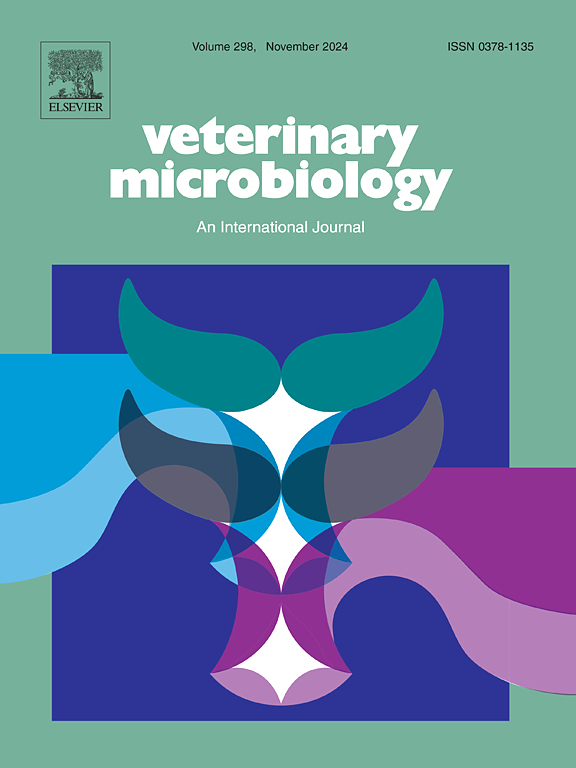Role and regulation of membrane efflux pumps in Staphylococcus pseudintermedius clinical isolates
IF 2.7
2区 农林科学
Q3 MICROBIOLOGY
引用次数: 0
Abstract
The overexpression of efflux pumps (EPs) is one of the strategies through which Staphylococcus spp. survive antibiotic treatment. This process is regulated by intricate and still not fully understood mechanisms. This study aimed to evaluate the efflux capability of Staphylococcus pseudintermedius clinical isolates, investigate its implications in multidrug resistance, and elucidate the molecular mechanisms underlying EP expression. Additionally, potential therapeutic approaches for inhibiting staphylococcal EPs were assessed. Phenotypic characterization of efflux activity included ethidium bromide (EtBr) MIC screening, fluorometry-based accumulation and efflux assays, and synergy tests with EP inhibitors (EPIs). The genetic basis of high efflux phenotypes was explored using WGS and qPCR. Based on EtBr MIC, nine out of 109 isolates (8.3 %) progressed to fluorometry tests, confirming high phenotypic efflux in six isolates (Spearman rs= 0.886). These were classified into distinct multilocus sequence types (ST71, ST496, ST551 and ST1062), with two isolates representing novel STs, designated ST2837 and ST2838. Synergism was observed when combining an EPI with EtBr, ciprofloxacin, clindamycin, and chloramphenicol; however, no EPI restored full susceptibility to these antibiotics. All isolates contained at least one plasmid-encoded EP gene, with qacG being the most common (6/6), followed by qacH (3/6), tetK (3/6), smr (2/6), qacJ (1/6), and msrA/B (1/6). Variable expression of EP genes was noted, with MFS-JC286_RS07290 overexpressed in all isolates, while MFS-JC286_RS11100 and MFS-JC286_RS11015 showed the highest expression levels. Comparative alignments suggested that the observed high efflux is unlikely due to mutational events upstream. These findings imply a potential role for transcriptional regulators, highlighting new research directions in this area.
膜外排泵在假中葡萄球菌临床分离株中的作用和调控
外排泵(EPs)的过表达是葡萄球菌在抗生素治疗中存活的策略之一。这一过程是由复杂的、尚未完全理解的机制调控的。本研究旨在评估假中葡萄球菌临床分离株的外排能力,探讨其在多药耐药中的意义,并阐明EP表达的分子机制。此外,还评估了抑制葡萄球菌EPs的潜在治疗方法。外排活性的表型表征包括溴化乙啶(EtBr) MIC筛选、基于荧光法的积累和外排测定,以及与EP抑制剂(EPIs)的协同试验。利用WGS和qPCR技术探讨高外排表型的遗传基础。基于EtBr MIC, 109个分离株中有9个(8.3 %)进展到荧光测定,证实了6个分离株的高表型外排(Spearman rs= 0.886)。这些菌株被划分为不同的多位点序列类型(ST71、ST496、ST551和ST1062),其中两个分离株代表新型STs,命名为ST2837和ST2838。EPI与EtBr、环丙沙星、克林霉素和氯霉素联合使用时观察到协同作用;然而,没有EPI恢复对这些抗生素的完全敏感性。所有分离株均含有至少一个编码EP基因的质粒,qacG最常见(6/6),其次是qacH(3/6)、tetK(3/6)、smr(2/6)、qacJ(1/6)和msrA/B(1/6)。EP基因的表达存在差异,MFS-JC286_RS07290在所有分离株中均过表达,而MFS-JC286_RS11100和MFS-JC286_RS11015表达量最高。比较比对表明,观测到的高外流不太可能是由于上游的突变事件。这些发现暗示了转录调控因子的潜在作用,突出了该领域新的研究方向。
本文章由计算机程序翻译,如有差异,请以英文原文为准。
求助全文
约1分钟内获得全文
求助全文
来源期刊

Veterinary microbiology
农林科学-兽医学
CiteScore
5.90
自引率
6.10%
发文量
221
审稿时长
52 days
期刊介绍:
Veterinary Microbiology is concerned with microbial (bacterial, fungal, viral) diseases of domesticated vertebrate animals (livestock, companion animals, fur-bearing animals, game, poultry, fish) that supply food, other useful products or companionship. In addition, Microbial diseases of wild animals living in captivity, or as members of the feral fauna will also be considered if the infections are of interest because of their interrelation with humans (zoonoses) and/or domestic animals. Studies of antimicrobial resistance are also included, provided that the results represent a substantial advance in knowledge. Authors are strongly encouraged to read - prior to submission - the Editorials (''Scope or cope'' and ''Scope or cope II'') published previously in the journal. The Editors reserve the right to suggest submission to another journal for those papers which they feel would be more appropriate for consideration by that journal.
Original research papers of high quality and novelty on aspects of control, host response, molecular biology, pathogenesis, prevention, and treatment of microbial diseases of animals are published. Papers dealing primarily with immunology, epidemiology, molecular biology and antiviral or microbial agents will only be considered if they demonstrate a clear impact on a disease. Papers focusing solely on diagnostic techniques (such as another PCR protocol or ELISA) will not be published - focus should be on a microorganism and not on a particular technique. Papers only reporting microbial sequences, transcriptomics data, or proteomics data will not be considered unless the results represent a substantial advance in knowledge.
Drug trial papers will be considered if they have general application or significance. Papers on the identification of microorganisms will also be considered, but detailed taxonomic studies do not fall within the scope of the journal. Case reports will not be published, unless they have general application or contain novel aspects. Papers of geographically limited interest, which repeat what had been established elsewhere will not be considered. The readership of the journal is global.
 求助内容:
求助内容: 应助结果提醒方式:
应助结果提醒方式:


